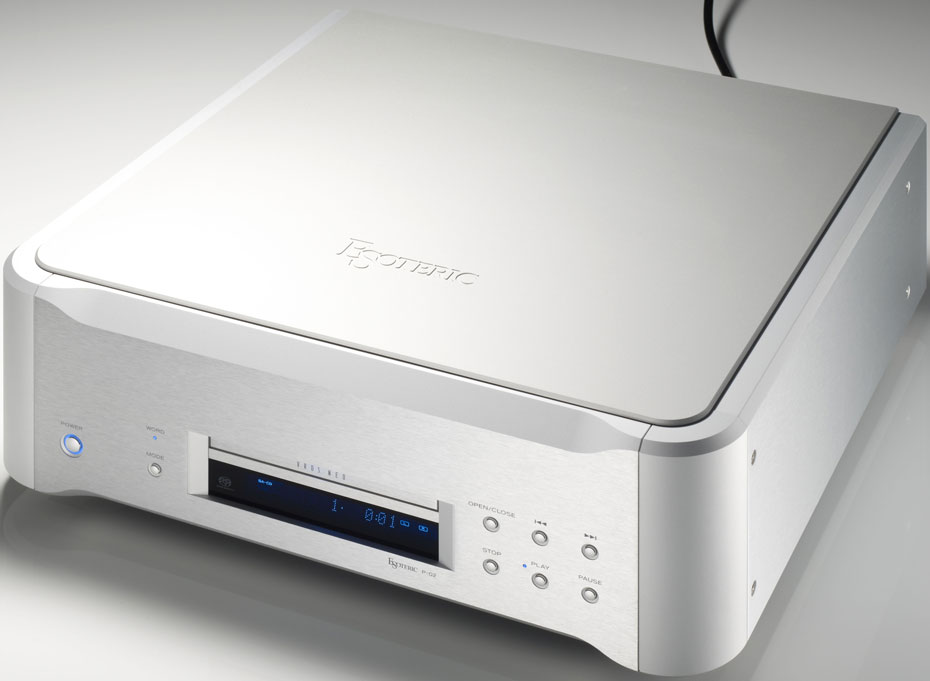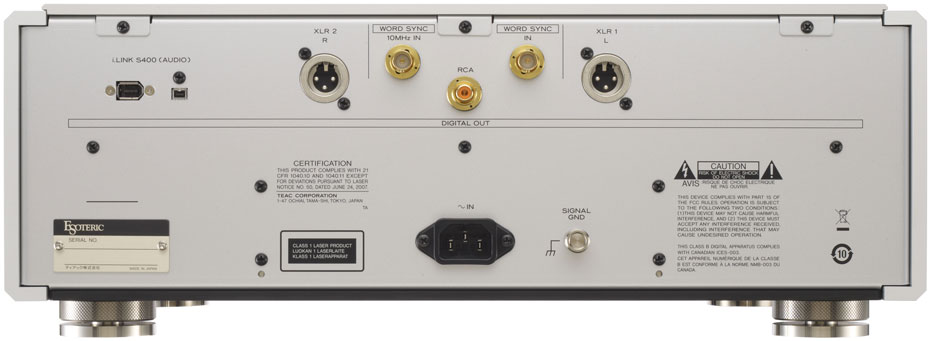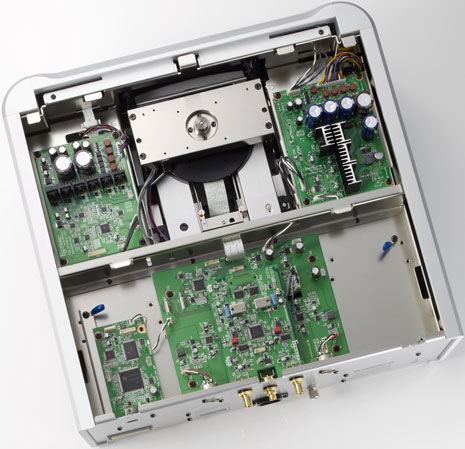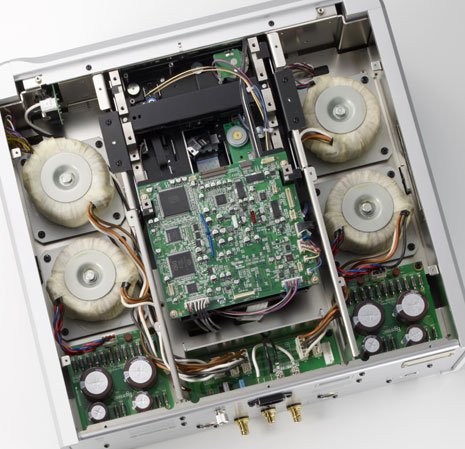Introduction
I want to begin by saying that I have always had a certain fondness for Esoteric equipment. Until three years ago, my digital reference was an Esoteric X01-D2 which operated flawlessly. That unit and in particular the more expensive separates are exceptional in terms of extracting detail. Esoteric transports are so well regarded that many other manufacturers use them. However, coupled with that detail was a certain lack of warmth that ultimately led me to replace my X01 with an EMM Labs XDS1. While I have thoroughly enjoyed the XDS1, it was hard to tear myself away from the memory of the exceptional level of detail of the Esoteric. This review is essentially about my giving the latest generation of Esoteric players another chance and deciding if they hit on the right mix of compromises. It is also to a lesser extent about how the latest technology from Esoteric, the P-02 Super Audio CD/ CD Transport and the D-02 D/A Converter fares in comparison to other units which I have heard, including the EMM Labs XDS1, the Esoteric P03/ D03/ G0s and K-01, the EAR Acute and the Audio Note CDT-5 Transport and Fifth Element DAC.
Technical information
Each of the units which comprise this digital duo begins with a heavy, rigid, non-resonant chassis which is up to the standards set by Esoteric in their other top of the line products, and represents the introduction of several significant technological advances. The P-02 uses the latest and best version of the Esoteric VRDS – NEO transport, the VMK-3.5-20S, which offers excellent stability and reliability. There seems little disagreement that while there are many transports available, the platinum standard in the industry is clearly the Esoteric. The transport (laser assembly and carriage) alone weighs 11.5 pounds. The D-02 uses eight 32-bit DAC circuits (four AK4399 chipsets) per channel, wired together to achieve 35-bit processing. The input signal is converted internally to 48-bit word length which allows enhanced processing capability in the digital domain. The analog section uses a fully discrete class-A buffer with four amps per channel. The clock’s circuits are assembled in modules that are completely isolated from the power supply, ground, and other circuit blocks. This newly developed clock module can provide the system with a pure clock output that is equivalent to (or exceeds), single unit external master clock generators currently available. I was able to compare the internal clock of the D-02 to Esoteric’s own G-0s and was able to detect little improvement in the resultant sound. The D-02 offers a selection of four digital filters that to some extent allow tuning of the sound, although in reality I found one that I consistently preferred. SACD’s are played in native DSD. The units use Esoteric’s proprietary connection standard, probably the highest audio bit rate standard available today.
Straight from the box
These are very heavy units, 68 and 60 pounds for transport and DAC respectively, which arrive well packaged in triple boxes. The exterior of each machine is elegant but understated, consisting of a simple brushed aluminum face and body. While the buttons on the faceplate that operate the unit other than the ON/ OFF switch are small and non-descript, they contrast starkly with the font used on the digital display of each piece. The display can be turned off. The D-02 offers the typical RCA and XLR outputs but also Esoteric’s proprietary ES-Link3 and an output for synching the clocks of the P-02 and D-02. ES-Link3 is an Esoteric protocol that uses dual XLR outputs at sample rates up to 384kHz at 24 bits, or 176.4kHaz at 48 bits. The back of the D-02 is similar in that it is designed to receive the corresponding inputs from the P-02 but also contains additional inputs for optical and USB (which increases its versatility) and audio outputs. The drawer to receive CD’s on the P-02 is slender and understated, elegant but solid to the touch. The transport inside works flawlessly. The remote has a very solid feel but I do wish that the buttons on the remote were backlit for easier use at night.
The P-02/ D-02 never sounds bad even straight out of the box, but improves considerably with extended break-in. Each of the filter options must be separately broken-in for approximately 200 hours. Given the rather Herculean power supplies of these units, I was somewhat surprised that they were quite sensitive to the power cord used. The stock cord was acceptable but significant sonic benefits could be had by using a more sophisticated aftermarket cord. In practice, two cords both manufactured by Stage III worked superbly on the units, namely a Vortex Prime on the transport and a Minotaur on the DAC. Use of these cords significantly lowered the already low noise floor, improved extension at the frequency extremes, tonality in the midrange, detail retrieval and recreation of space and realism of the soundscape. I used a Stage III Zyklops from the wall to a Weizhi AC distribution box, and the Vortex Prime and Minotaur from there to the P-02/ D-02. Later in the listening, I substituted one of Frank Latimer’s AC distribution boxes with excellent results. Likewise, the P-02/ D-02, though with very well designed feet, benefitted from more sophisticated mechanical isolation, much in the same way as did the Esoteric X01-D2. Siting the units on a Finite Element Pagode Master Reference equipment stand with Cerabases between them and the shelf wrought a nice improvement, but substitution of a Halcyonics isolation base was clearly the preferred choice for each. The Halcyonics provided a much lower noise floor, better dynamics, better focus and depth, and better inner detail.
Software
Numerous discs were played during the review period, but several were used repeatedly:
With the P-02/D-02, track 2 of Steve Kahn – The Suitcase Live in Koln ’94, (Tone Center TC-40632) was less etched than the K-01 or the earlier X01-D2. The sense of detail from Redbook CD’s is impressive. I was previously not aware of the depth of detail that existed. This CD had a good dynamic range which helped with the sense of where the instrument was located in space. Recreation of soundstage, particularly the air around individual instruments was a strong point. In comparison to the EMM Labs XDS1, there was some diminution of air at the top, while localization of instruments was excellent. Cymbals could at times be a bit mono-chromatic, the top end a bit polite using the factory settings; however, changing to 4X upsampling and the S_DLY1 digital filter pretty much eliminated this as an issue.
Prometheus Hugo Wolf- Harmonia Mundi HMC 901837: Detail and placement of instruments and voice are absolutely fabulous. Pizzicato strings are very realistic. Amazingly, you can hear a group of individual string players instead of a homogenized percussive noise. Tympani is really vivid, you can hear the mallet on the skin of the tympani. Strings sound lush. Male and female voices are beautifully placed and are full and round, very detailed without being etched. This is a CD that drove me to occasional distraction on the earlier X01-D2. The strings and winds were nice but the voices, particularly baritone Dietrich Henschel, cut like a knife. I never made it past the second track before pushing the EJECT button with previous players. This is no longer the case. On the orchestral side, this CD is one of the great overlooked beauties of the digital generation. The voices are still a bit hard but the whole experience is so sensually satisfying that when I hit the EJECT button this time, it will be to see what other Harmonia Mundi’s I have overlooked.
Bill Frisell Good Dog, Happy Man Nonesuch 79536-2; placement of images is much better than on any other machine with which I am familiar. Detail almost distracts one from the music, yet is very seductive. This is reminiscent of the detail and intimacy of headphones without their negative localization effects.
Debussy Images for Orchestra JVC XRCD 0004- in terms of detail retrieval and transparency, this is the best that I have ever heard this CD sounded, and in general, the JVC XRCD’s are some of the very best available. Some might describe the presentation as somewhat “clinical” or “dry” and I cannot really argue with that. However, I have not heard anything with a “warmer” or more “lush” presentation that also presents with this level of transparency, and the transparency can itself be extremely seductive. In the “Iberia” in the loud portions, there could at times be a certain harshness in the brass. This may be an artifact of the current state of the master tape, as I do not recall this from the Shady Dog LP.
- (Page 1 of 2)
- Next page →





I am a reasonably hi-end audiophile (Esoteric P/D-05, Graaf GM13.5B II pre and GM200 amp, Wilson Benesch Bishop speakers, 4 KVA balanced power supply) and was finding this interesting reading until I got to:
“Each of the filter options must be separately broken-in for approximately 200 hours. Given the rather Herculean power supplies of these units, I was somewhat surprised that they were quite sensitive to the power cord used.”
Man, Fred, talk about shooting yourself in the foot! what a load of bollocks!
Dear Mark,
Unfortunately, a Herculean power supply does not completely obviate the need for a well designed power cord. I would note that EMM Labs includes an aftermarket power cord with each XDS1 and that has the best thought out power supply of any unit that I have seen. In this case, power cords do for whatever reason have an impact on the sound of both the P-02 and D-02, and the same cord does not work optimally on each, which means that I am using a Stage 3 Vortex Prime on the transport and the more expensive Stage 3 Minotaur on the DAC. I did try Minotaurs on both and the less expensive Stage 3 sounded better on the transport. With respect to breaking-in the filters, the information that each must be broken-in separately came directly from Esoteric, as did the 200 hours. I can only say that it clearly made a difference on the filter that I chose in the end. As always, your mileage may vary. I would merely caution you against assuming that you are better informed than the manufacturer. On the other hand, always challenge reviewers if your experience varies from theirs. I have heard many pieces of digital equipment in my system, the P-02/ D-02 is the best so far. Note that I have not heard the newest DCS 4-box setup in my system but am impressed with what I hear at shows. Digital is one of those areas which continues to improve audibly.
Thanks for your note.
Fred
Fred,
Admittedly, I am tempted to buy some audio products just because they just look downright gorgeous but I primarily buy products that apply good engineering to improving audio.
Take the Wilson Benesch Bishops as an example – a full on, virtually lunatic assault on speaker engineering e.g. infinite baffle (no resonant ports to affect the response), 8 isobarik drivers per speaker to reduce speaker volume, narrow frontal aspect to improve imaging, carbon fibre to absorb rather than reflect sound, virtually no crossover network, etc.
The Graaf GM 200 – full on, virtually lunatic assault on tube amplification e.g. OTL, so no output transformer, 32 output tubes to drive low impedance speakers but also to cancel harmonics.
Esoteric SACD player and DAC – full on assault on digital e.g. lunatic attention to mechanical aspects as well as in their DACs, external clocks, etc.
Now, can I hear the difference between speaker cables? Yes, I can.
Can I hear the difference between a 6922 and a CCa tube? Absolutely.
Can I hear the difference between a solid state amplifier that has been “burned in” for 200 hours and one that hasn’t? Not a chance! To prove my point, have you EVER come across a reviewer who has concluded that an amp/DAC/preamp sounded worse after burn in? Always better, right? Why, exactly, should that be the case? I’ll tell you why… because it is in your head!
As far as power cables are concerned, with the lunatic level of engineering that Esoteric applies to their products, I can’t believe that they would cripple the SACD player that they went to the trouble of purpose building a sled to avoid the slightest vibration by supplying a second rate power cable! Not to even start going down the path of what difference a 1.5m of power cord in a 500m chain of questionable quality copper cable and joints to the nearest supply transformer would make! The pretty jacket and the price of that fancy $2000 power cable is what is messing with your head!
Fred:
Really enjoyed reading this article. Thanks for your insights and experience you bring to this review—I am always heartened by those that have spent a lot of time listening to digital audio before reviewing products such as this. I purchased a K-01 less than a year ago and wondered a couple of things: in the arena of after market power cords, have you found one that works particularly well with Esoteric? I still have the stock cord… Also, do you think this next generation of external clocks, either by Esoteric or other companies such as MSB, would benefit the K-01? Both my experience and budget pales in comparison to the things you’ve mentioned here, but I have found significant pleasure in this K-01! For me, it has been the best digital I’ve heard. Am I crazy that the default Redbook layer, with a year on it, sounds better than the other filter options I’ve tried recently?
Phil,
Thanks for your kind words. It has been my experience that the more positive my reaction to a product, the easier it is to write a review. I have had very good luck using Stage III power cords on the Esoteric products as has my friend who owns the K-01. I would highly recommend the Minotaur or for about half the price the Vortex Prime. The Minotaur is quieter and has a more controlled bass but both will enhance the performance of the K-01. The clock in the K-01 is actually quite good but can be improved upon. I would strongly suggest either the newest G-0 from Esoteric or for much less a used older G-0s which can often be had for extremely good prices. I have also heard good things about the MSB but have not auditioned them in my system.
Fred
Excellent comment about burn-in always improving performance! Am totally in agreement with point about 1m of power cord supposed to work wonders and a manufacturer spending gazillions will overlook the benefits of a $5 accessory part. All in the mind of the reviewers. Simply enjoy the pictures of components and a list of features – learn to ignore the hyperbole.
Fred,
Thank you for your review of the D-02. I currently have one on order and am curious which filter and up sampling setting you used for your review? With 200 hours of breaking in per setting I thought it would be wise to start with some known variables. As to the remainder of the digital chain, I am using an Aurender S10 server, an Esoteric A02 amp and C03 preamp. Power cords are all Nordost Valhalla, interconnects are Nordost Valhalla, V2 and Odin, speaker cables are Nordost Odin. I also have Stillpoints Ultra SS under all main components for vibration control. I am really looking forward to the arrival of the D-02 and would appreciate any info you can share to assist me in setting the unit up.
Regards,
Paul
I know it s outdated but l would like to know witch one of these these two is better ,i am hesitating between the two,the esoteric p02 d02 vs emm labs tdsx dacx2
thank you